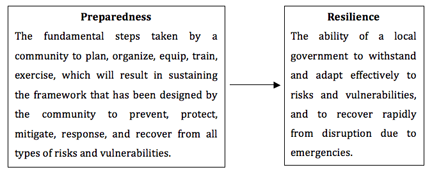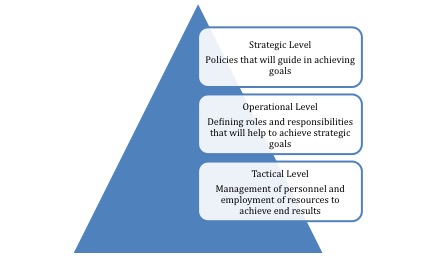Natural disasters begin locally and may affect one or more communities simultaneously. However, a community approach to preparedness and resilience – with local government officials identifying the different natural disasters that make their communities vulnerable – can greatly influence response and sustainability efforts to counteract potential challenges. To achieve effective resilience, preparedness should be systematic.
 The cost of managing natural disasters in the United States has sharply increased over the last decade. Subsequently, the U.S. federal government finds it challenging to provide enough disaster relief funds to support local governments’ management of activities related to natural disasters. Through proactive actions, local governments can identify methods and best practices to help their communities effectively prepare for natural disasters based on their specifimc risks and vulnerabilities.
The cost of managing natural disasters in the United States has sharply increased over the last decade. Subsequently, the U.S. federal government finds it challenging to provide enough disaster relief funds to support local governments’ management of activities related to natural disasters. Through proactive actions, local governments can identify methods and best practices to help their communities effectively prepare for natural disasters based on their specifimc risks and vulnerabilities.
Federal Support Efforts
The Federal Emergency Management Agency (FEMA) has developed many resources to help communities prepare for disasters. A local community that is resilient to natural disasters forms the basis for a resilient nation. In an era with many means for receiving and sharing knowledge, local emergency managers can easily explore ways to address their natural disaster challenges, which other localities may have already experienced or are currently initiating actions to address similar challenges.
Moreover, templates that have been developed and tested by FEMA and other emergency management organizations may shape a preparedness framework even for a novice emergency manager. If the goal of preparedness is to ensure resilience for the whole community, preparedness actions should take into considerations any potential risks and vulnerabilities (see Fig. 1). In addition, all community stakeholders should be part of the preparedness framework.

Fig. 1. Relationship of preparedness to resilience (Source: Author).
The preparedness framework recommended by FEMA involves planning, organizing, training, exercising, and evaluating. Some of the guides to help in preparedness include: the National Incident Management System (NIMS), NFPA 1600 (Standard on Disaster/Emergency Management and Business Continuity/Continuity of Operations Programs), and Presidential Policy Directive (PPD-8). Looking at preparedness from a comprehensive perspective is essential because sometimes emergency managers may not overtly identify all potential risks and vulnerabilities within their environments or associated risks and vulnerabilities that may result from a disaster.
Comprehensive preparedness helps community efforts in areas of prevention, protection, response, recovery, and mitigation through the engagement of emergency managers and local community members addressing all risks and vulnerabilities in their environments. Local community concerns have to be tabulated and synchronized to ensure that all community emergency management priorities are addressed immediately. The guidelines for addressing priorities involved look at preparedness at different levels: strategic, operational, and tactical (see Fig. 2).

Fig. 2. Levels of preparedness pyramid (Source: Author).
Steps to Achieve Resilience
Some practical steps recommended by FEMA that may help a local community achieve its preparedness and resilience goals include:
- Identifying and addressing risks: This process involves a combination of different aspects such as: assembling historical data of potential and perceived risks and hazards, and all other relevant information that may affect community safety. An effective evaluation of community risks and vulnerabilities forms the basis for necessary actions.
- Estimating capabilities requirement: Locating and listing capabilities that are essential to addressing identified risks are essential. Some capabilities may already exist and some may still need to be developed. Core capabilities in the areas of protection, prevention, mitigation, response, and recovery must also need to be reviewed.
- Building and sustaining capabilities: Local community emergency managers should identify the best ways to use their limited resources to build capabilities. Properly assessing risks results in prioritization of resources to address risks and vulnerabilities based on probability.
- Planning to deliver capabilities: The planning process for the delivery of capabilities should involve whole community coordination with: individuals, businesses, nonprofits, community and faith-based groups, all levels of government, and other organizations.
- Validating capabilities: Testing capabilities through exercises and other activities addresses the gaps in plans and capabilities. It is very important to regularly assess progress that has been made toward preparedness.
- Reviewing and updating: The conditions of an environment regularly change, so it is essential to regularly review guidance, programs, and processes to ensure capabilities, resources, and plans are up to date.
Preparedness efforts can yield maximum results when local stakeholders understand their roles and take advantage of the resources available to build the necessary framework for effective resilience to all types of natural disasters.
